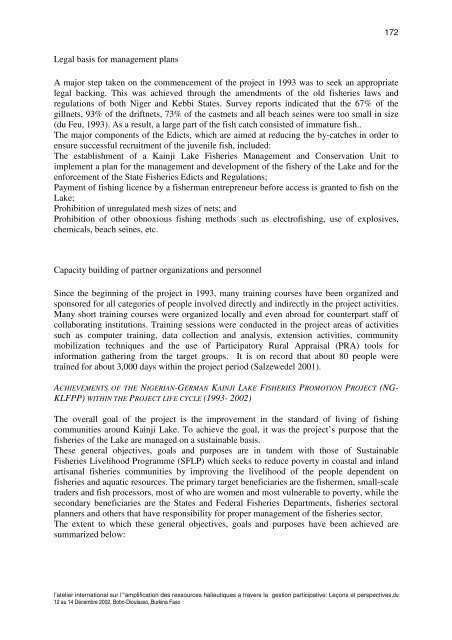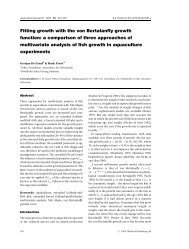RAPPORT GENERAL DE L'ATELIER ... - Nefisco.org
RAPPORT GENERAL DE L'ATELIER ... - Nefisco.org
RAPPORT GENERAL DE L'ATELIER ... - Nefisco.org
Create successful ePaper yourself
Turn your PDF publications into a flip-book with our unique Google optimized e-Paper software.
172<br />
Legal basis for management plans<br />
A major step taken on the commencement of the project in 1993 was to seek an appropriate<br />
legal backing. This was achieved through the amendments of the old fisheries laws and<br />
regulations of both Niger and Kebbi States. Survey reports indicated that the 67% of the<br />
gillnets, 93% of the driftnets, 73% of the castnets and all beach seines were too small in size<br />
(du Feu, 1993). As a result, a large part of the fish catch consisted of immature fish..<br />
The major components of the Edicts, which are aimed at reducing the by-catches in order to<br />
ensure successful recruitment of the juvenile fish, included:<br />
The establishment of a Kainji Lake Fisheries Management and Conservation Unit to<br />
implement a plan for the management and development of the fishery of the Lake and for the<br />
enforcement of the State Fisheries Edicts and Regulations;<br />
Payment of fishing licence by a fisherman entrepreneur before access is granted to fish on the<br />
Lake;<br />
Prohibition of unregulated mesh sizes of nets; and<br />
Prohibition of other obnoxious fishing methods such as electrofishing, use of explosives,<br />
chemicals, beach seines, etc.<br />
Capacity building of partner <strong>org</strong>anizations and personnel<br />
Since the beginning of the project in 1993, many training courses have been <strong>org</strong>anized and<br />
sponsored for all categories of people involved directly and indirectly in the project activities.<br />
Many short training courses were <strong>org</strong>anized locally and even abroad for counterpart staff of<br />
collaborating institutions. Training sessions were conducted in the project areas of activities<br />
such as computer training, data collection and analysis, extension activities, community<br />
mobilization techniques and the use of Participatory Rural Appraisal (PRA) tools for<br />
information gathering from the target groups. It is on record that about 80 people were<br />
trained for about 3,000 days within the project period (Salzewedel 2001).<br />
ACHIEVEMENTS OF THE NIGERIAN-GERMAN KAINJI LAKE FISHERIES PROMOTION PROJECT (NG-<br />
KLFPP) WITHIN THE PROJECT LIFE CYCLE (1993- 2002)<br />
The overall goal of the project is the improvement in the standard of living of fishing<br />
communities around Kainji Lake. To achieve the goal, it was the project’s purpose that the<br />
fisheries of the Lake are managed on a sustainable basis.<br />
These general objectives, goals and purposes are in tandem with those of Sustainable<br />
Fisheries Livelihood Programme (SFLP) which seeks to reduce poverty in coastal and inland<br />
artisanal fisheries communities by improving the livelihood of the people dependent on<br />
fisheries and aquatic resources. The primary target beneficiaries are the fishermen, small-scale<br />
traders and fish processors, most of who are women and most vulnerable to poverty, while the<br />
secondary beneficiaries are the States and Federal Fisheries Departments, fisheries sectoral<br />
planners and others that have responsibility for proper management of the fisheries sector.<br />
The extent to which these general objectives, goals and purposes have been achieved are<br />
summarized below:<br />
l’atelier international sur l’“amplification des ressources halieutiques a travers la gestion participative: Leçons et perspectives,du<br />
12 au 14 Décembre 2002, Bobo-Dioulasso,,Burkina Faso



